Selling on Amazon in 2023: How to Kickstart Your Strategy
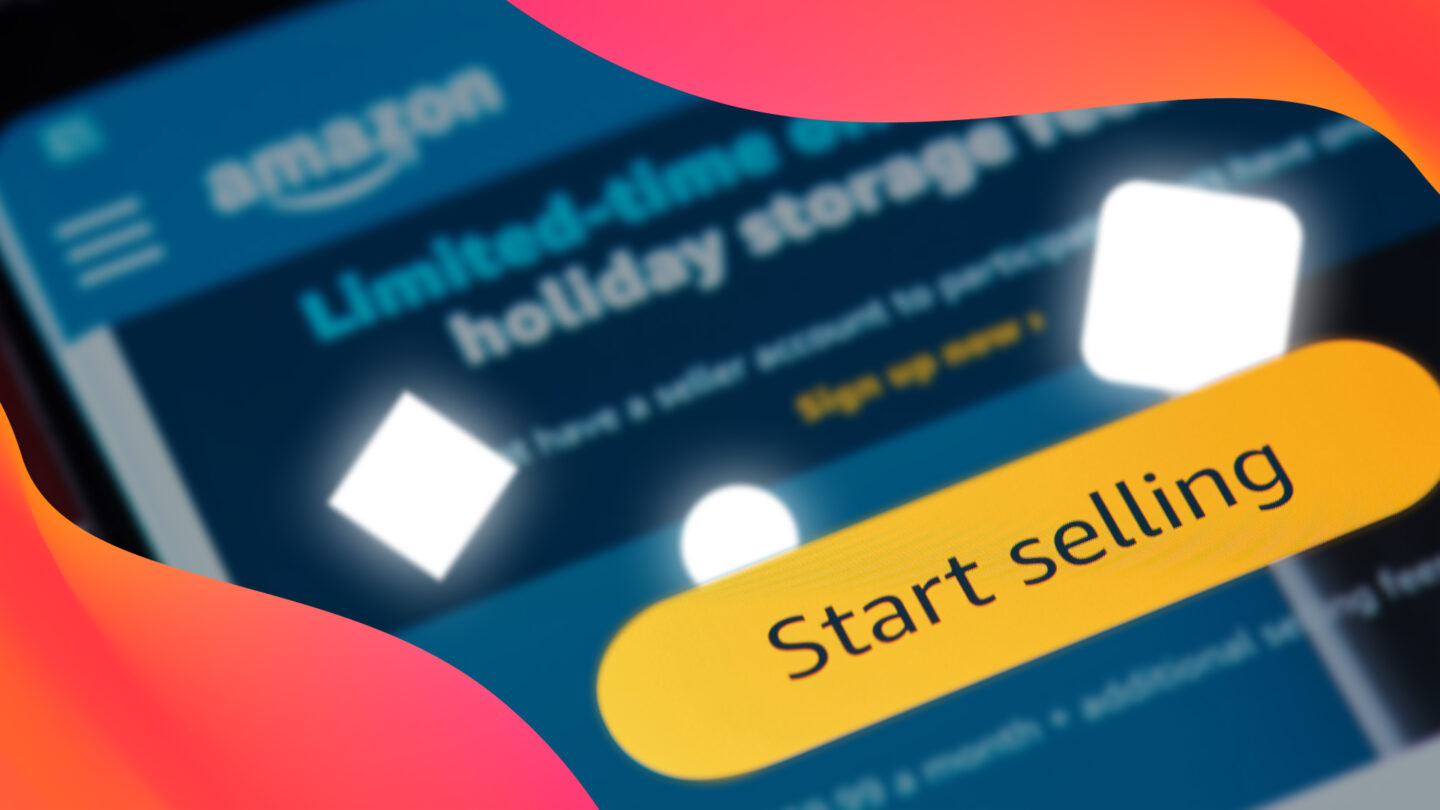

The Amazon Marketplace is one of the most well-known and popular marketing channels for online retailers. This is due in part to the incredible brand-building potential selling on Amazon offers, but it’s also more simply because of all those prospective customers.
Maintaining an active presence on Amazon was once considered nice-to-have for many retailers, but today, many brands find it an absolute necessity. In order to make sales, your products have to be available where people are shopping, and people are most certainly shopping on Amazon…
Amazon is continuously maturing and evolving in all aspects of its business, from enhancements to Amazon Creative, to the launch of Amazon Marketing Cloud, Amazon Moments, Buy With Prime, and so much more.
Content, inventory, search advertising, display, video, targeting, measurement and reporting, and more—the world of Amazon can be overwhelming if you’re just starting out on the platform! But we’re here to break it all down, diving into all the ins and outs you need to understand to successfully sell on Amazon in 2023 and beyond.
Keep reading for a step-by-step list covering how to sell on Amazon.
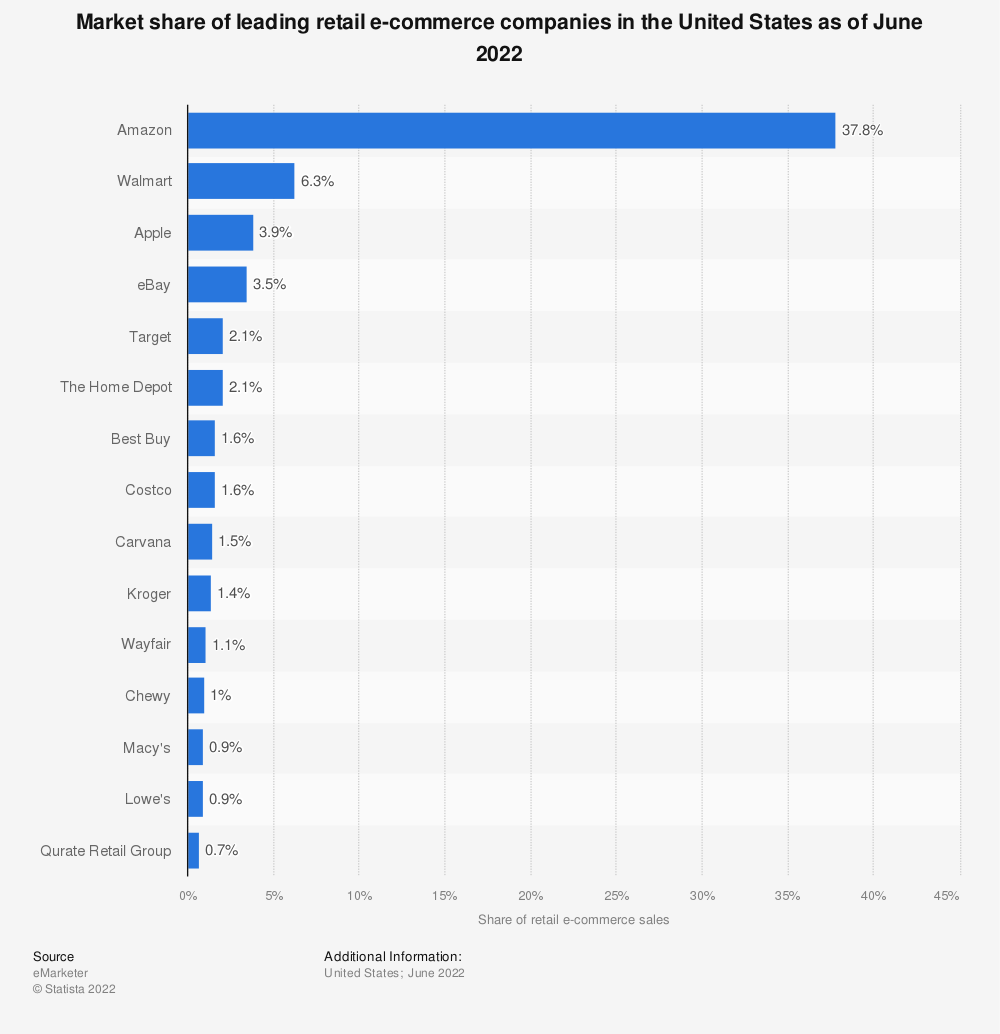
Weighing the primary pros and cons of selling on Amazon can help you determine if it’s the right fit for your brand, and serve as an easy-to-reference checklist to revisit if you decide to move forward. While many of the pros and cons you’ll likely add to your list will be dependent on your unique situation and business goals, there are a few to consider that are relevant to most brands…
Benefits
Drawbacks & Considerations
As profitable and beneficial for brand-building as selling on Amazon can be, there are key differences from how you approach selling on your own site. Sellers on Amazon are essentially tenants, and have to abide by the landlord’s rules and policies.
Let’s explore a few primary differences to consider…
Before we dive into important tips to help you sell on Amazon, it’s important to distinguish between first-party and third-party sellers.
Vendors, or first-party sellers, use a program called Amazon Vendor Central to manage their account. Vendors sell their inventory to Amazon for a wholesale rate, then Amazon sells the product directly to consumers.
Amazon vendors are part of an invite-only program for manufacturers and distributors, with Amazon reaching out to express interest in buying their product or products directly. This is typically done if a brand/product has historically solid selling performance on the platform, or is a well-established brand/product. These listings will display as being both sold by Amazon, and fulfilled by Amazon.
However, the majority of sellers on Amazon are Third-Party Sellers, who use an interface called Amazon Seller Central. This requires sellers to list, price, and market their own products, and also leaves sellers responsible for organizing and monitoring inventory, pricing, advertising, reports, and more. With that said, being a third-party seller has its perks:
Selling through Amazon Seller Central is generally more work than selling through Amazon Vendor Central, but it’s also open to a larger group of sellers, and comes with greater levels of control around shipping, prices, and fulfillment—not to mention the potential for higher margins.
Ready to dive in? Let’s take a top-down approach outlining how to sell on Amazon…
If you’ll be selling products on Amazon that you already sell on other online marketplaces, including your own retail website, you already have a healthy head start on the market and product research. That said, you aren’t done!
Whether you’re a new seller, or an established ecommerce retailer in other spaces, it’s important to conduct Amazon-specific market and product research. The factors and tactics that drive shoppers to your ecommerce site may differ quite a bit from what will lead to success on Amazon.
A few things to consider in your research:
Your business plan on Amazon should start by identifying your primary goals—why do you want to sell on Amazon in the first place? What do you want, or need, to get out of selling on Amazon to consider it “a success?”
From there, it can be helpful to assign a hierarchy to your goals. Knowing which goals are most important will help everyone in your organization better understand what to do, and how to do it, in ways that ladder up to the desired outcomes. It will also help in resource allocation, as you’ll want to be sure your primary goal is supported in every business decision you make.
Some things you’ll want to consider in building your business plan include:
If you’ll be selling entirely new products for which you don’t already have inventory, you’ll need to dedicate time to researching reliable suppliers. This can be done via the internet, or in person, such as connecting through trade shows. Top considerations when determining a good fit include:
When choosing an Amazon Seller Plan—Individual or Professional—the most important thing to consider is how many products you plan to list for sale on the site. The totality of the sales you anticipate on the platform should be your guiding light when deciding on a plan.
Both Individual and Professional Seller plans allow for listing products across a wide selection of common categories, with some additional categories available only to Professional Sellers who apply for permission and meet the necessary requirements. Categories exclusively available to Professional Seller accounts include fine art, fine jewelry, collectible coins, and more.
The major differences between the Professional Amazon Seller Plan vs. the Individual Seller Plan include:
Individual Plan: Best if you are an entry-level or niche seller that expects to sell fewer than 40 items per month. There’s no monthly subscription fee, but your selling fees are $0.99 per item in addition to referral fees and additional selling fees.
Professional Plan: Most established brands will start here – particularly if they plan to leverage Amazon advertising, which is only available for Professional plans. The monthly subscription fee is currently $39.99 (with no $.99 per item fee), in addition to referral fees and additional selling fees.
Other key features and benefits a Professional plan offers that an Individual plan doesn’t include: Buy Box eligibility; sales tax collection on items sold; API integration available; create listings in bulk; manage your inventory with feeds, spreadsheets and reports; ability to grant user permissions; on-site advertising tools.
To get started, visit the “Sell on Amazon” page and click the ‘Sign up’ bubble. Some things you’ll need on-hand to begin registration include: a credit card that can be charged internationally; banking information, including your routing and account numbers; tax identification information.
If you’re a regular Amazon shopper yourself, chances are good you already have hundreds of emails from them in your inbox. To help in keeping your personal and business-related Amazon emails separate, we recommend using a different email address for your business than the one already linked to your personal Amazon Prime account. If you don’t already have a separate account, consider creating one in Gmail before logging into Seller Central. Keep in mind every Seller Central account you open will require a unique email.
Once you’ve decided on a login, Amazon will prompt you to fill out several additional steps, including:
Once you complete these steps you will be officially welcomed to your Seller Central dashboard, which includes a variety of tabs for managing inventory, pricing, orders, advertising, reports, and performance.
Don’t forget to list your products and fill out the “About Seller” to let the Marketplace know about your business. You can also include your company logo, FAQs, and your privacy policy.
If the identical product you’re adding already exists on Amazon, you’ll add your product using the existing listing. If this will be a brand new product for which you’re the only seller, you’ll start by creating a new listing.
Below—within Best Practices for Advertising Products Sold on Amazon—we explore how to fully optimize your product detail pages, including how to best structure your title, and use keyword-rich descriptions for optimal discoverability. Some basic listing details you’ll need to get started adding products include:
You can be doing all the right things on Amazon to get shoppers to your listings, but if your products aren’t in stock, you’ll lose 100% of your potential sales. Effective inventory management is more important than ever, especially if you’re an Amazon seller. In recent years, Amazon introduced monthly long-term storage fees for slow-moving inventory, increased FBA fees, and launched the new Inventory Performance Index (IPI) metric.
There have also been improvements to the basic inventory management features available in Seller Central. What these changes have in common is a mission to help Amazon merchants manage their inventory more effectively. However, some sellers face special challenges when managing their Amazon inventory—particularly if they are self-fulfilling (not leveraging FBA). If that rings true for you, you may want to invest in an Amazon inventory management tool.
Before you can actually start selling, you need to determine if you want Amazon to handle fulfillment of your products, or if it would make more sense to handle your own order fulfillment when purchases come through. Current Amazon fulfillment options include:
Let’s break these down to better understand each option.

Fulfillment by Amazon (FBA) is a program where Amazon stores, packs, ships, and handles customer service for the products you sell on Amazon. FBA gives you the ability to sell products with free and/or fast shipping and delivery, which can help increase sales.
“Prime members love FREE Two-Day Shipping, and all Amazon.com customers can get free shipping on eligible orders. When you list products for FBA, they are eligible for free shipping, too. Qualified FBA listings are displayed with the Prime logo, so customers know that Amazon handles packing, delivery, customer service, and returns.” — Amazon
FBA is a fulfillment option that sellers can choose for any or all of their products. Sellers vary on the number of products they choose to fulfill (if any) using FBA, with primary considerations including their sales volume, margins, product category, and related seller variables.
Fulfillment by Amazon is a great option for merchants who are looking to efficiently and reliably improve shipping times, while reducing time, money, and resources they must allot to fulfillment, including storage and distribution.
The launch of FBA was a game-changer for many brands and businesses that don’t have the time, desire, or necessary infrastructure, expertise, or workforce to handle fulfillment as well as Amazon is equipped to do. Some key benefits FBA offers include:
Now for the biggest con (for most sellers) to FBA: the cost.
Amazon seller fees result in a charge of a percent of total sale profits. In addition to those fees, FBA charges fees based on:
For some sellers, FBA initially seems like an expensive option, but keep in mind that leveraging FBA makes Amazon your logistics partner. At Tinuiti, we use our FBA Profitability Analysis Tool to help our clients determine if their products will be profitable using FBA.
Amazon Fulfillment impacts your margin for individual products, which arguably limits profitability. However, with the increase of total sale volume and exposure, FBA is likely a good investment for your online store. For example, you may make less money on an individual product—such as a single water bottle—but you are likely to sell more water bottles overall for a larger holistic profit.
Like the idea of FBA for some of your products, but still want to handle fulfillment on your own for others? You can do that!
Sellers using FBA don’t have to use the FBA option for all of their products, allowing you to calculate which products are profitable to fulfill with FBA. FBA may not be a strong option for your store depending on the competition surrounding your products, what products you sell, where your business is located, your margins, and other related variables, but its advantages make it worth exploring for all sellers.
Amazon Fulfilled by Merchant (FBM) makes you responsible for picking, packing, and shipping the products you sell on the Amazon Marketplace. FBM does not give you the option to list products as “Prime.”
The biggest benefit of FBM is that you’ll avoid some of the fees that come with FBA. However, you’ll be required to abide by all of Amazon seller rules (i.e. replying to customer support issues within 24 hours, provide tracking info, and shipping within your stated time frame).
Self-fulfillment takes more work, but is doable if you already have the right infrastructure in place to handle all of the above.
Unfortunately, and importantly, with FBM you will not have access to selling via Amazon Prime (unless you’re selling with Seller Fulfilled Prime – see below), which in turn will lead to less sales than a comparable FBA offering.
Seller Fulfilled Prime (SFP) is a hybrid Amazon fulfillment option that gives you the ability to store, pack, and ship products from your own warehouse, while allowing your products to be listed with the conversion-boosting Prime badge. Just remember—that badge comes with responsibility.
“Seller Fulfilled Prime is the Prime program that allows you to deliver directly to domestic Prime customers from your own warehouse. By displaying the Prime badge, you are committing to fulfill orders with Two-Day Delivery at no additional charge for Prime customers.” — Amazon
Qualifying for SFP isn’t easy, requiring you to “complete a trial period to show that you are able to meet the requirements for Prime fulfillment excellence and customer satisfaction.” During the trial period, you’ll need to satisfy all of Amazon’s outlined requirements. These include (but are not limited to): Offering premium shipping options; shipping 99%+ of your orders on time, and meeting the 1-day or 2-day delivery promise; maintaining an OCR (order cancellation rate) below 0.5%; using Amazon Buy Shipping Services for at least 99% of your orders.
Seller Fulfilled Prime is the best of both worlds for businesses with a solid fulfillment strategy, but there is no room to slack. Amazon holds SFP orders to very high standards, with ambitious requirements.
If you’d like to explore SFP, check to see if Amazon is currently accepting new registrants. If not, there may be an available waitlist to join.
Multi-channel fulfillment—an option within FBA—is designed to help sellers active across two or more sites or channels access the same inventory for all order fulfillment, no matter where the sale comes through. With Amazon MCF, you ship all of your inventory to Amazon’s fulfillment centers. When orders come through, Amazon will pack and ship them on your behalf, including those that come through your own website.
By utilizing Amazon MCF, sellers who struggle to maintain efficient shipping and delivery speeds can leverage “the world’s largest fulfillment network to provide fast, reliable ecommerce fulfillment wherever orders are placed.” While FBA and MCF come at a cost, the improvement in customer satisfaction can help improve your reviews, and fuel your business growth on and off Amazon.
Once you have all your products listed on Amazon, optimization and advertising can help give them additional visibility, and a boost in sales. Let’s explore some of the most important things to consider when optimizing your listings, and advertising on Amazon.
Almost anyone can list on Amazon, but not every seller is following the Amazon SEO best practices that are essential to securing visibility and sales. Detailed product listings can help your product rank above a competitor’s for relevant queries. Additionally, providing shoppers with all the needed information once they land on your page can play a huge role in increased conversions, so it’s truly a win-win to button everything up.
Here are a few tips to get you started…
Amazon product title lengths are determined at the category-level, and are the same for Fulfillment by Amazon (FBA), Seller Fulfilled Prime (SFP), and Merchant Fulfillment Network (MFN) listings. Review Amazon’s category-specific style guides to find the preferred style for products within your category.
Take time to create strong, detailed product titles that make the most of Amazon’s character count limit, including keywords that could help your product rank better for a variety of relevant searches. Don’t keyword stuff, but think beyond the product-focused keywords themselves to things you can naturally incorporate into the title, like ingredients, product attributes, and/or desired effects. If you are selling a shampoo, for example, in addition to including the brand and size in the product title, you might mention if it’s cruelty-free, volumizing, or includes a certain ingredient that shoppers might be searching for, like tea tree or argan oil.
To create product titles (product names) that help you appear in shoppers’ searches, and encourage strong click-through, we recommend following these best practices:
While a detailed product title is immensely helpful for sellers and buyers alike, there are a few details you shouldn’t include.
The Amazon product detail page bullet points—aka “Key Product Features” section—is located under the “Descriptions” tab. Product features are the second most important factor in surfacing your products, so you’ll want to maximize your character count here as well. Amazon shoppers rely heavily on bullet points to gather top takeaways at a glance. The more descriptive the bullet points for your product pages, the better your sales are likely to be.
Try to include the following in your listing’s bullet points:
As with product titles, there are a few things you shouldn’t do when writing bullet points for your key product features. For example:
Product descriptions are typically a few paragraphs long, and should explain the major product features, such as size, style, and what the product can be used for. Amazon encourages sellers to include accurate dimensions, care instructions, and warranty information, and use correct grammar, punctuation, and complete sentences.
Note that as of July 17, 2021, Amazon no longer allows the use of HTML tags in product detail page descriptions, with the exception of line breaks (<br>). The use of light HTML—such as adding bolding to text to help it stand out—was common practice, with Amazon citing security concerns and potential accessibility issues as the reasons for removing HTML tagging capabilities.
In addition to HTML tags, other things you shouldn’t list in your product description include:
Additionally, if you’re selling products in a category that Amazon regulates, make sure to carefully read all requirements so you don’t risk your listing getting taken down for using the wrong terms.
All Amazon detail pages require at least one main product image be shown, but additional images and videos can help greatly in securing buyer confidence and increasing sales. Put your best self forward with clear, eye-catching, information-rich images that enhance product understanding and appeal.
Amazon’s image requirements and site standards include:
Note that there are additional site standards for Main product images, with the above criteria serving for all images.
By following these best practices, you’ll be able to stay in Amazon’s good graces while ensuring your product listing is compelling.
Amazon’s Buy Box is a coveted section on the right side of an Amazon product detail page where customers can click to add a product to their cart, or make an instant purchase. The majority of Amazon customers shop using the Buy Box, with many not even being aware that for some listings, there are multiple sellers they can choose to shop from.
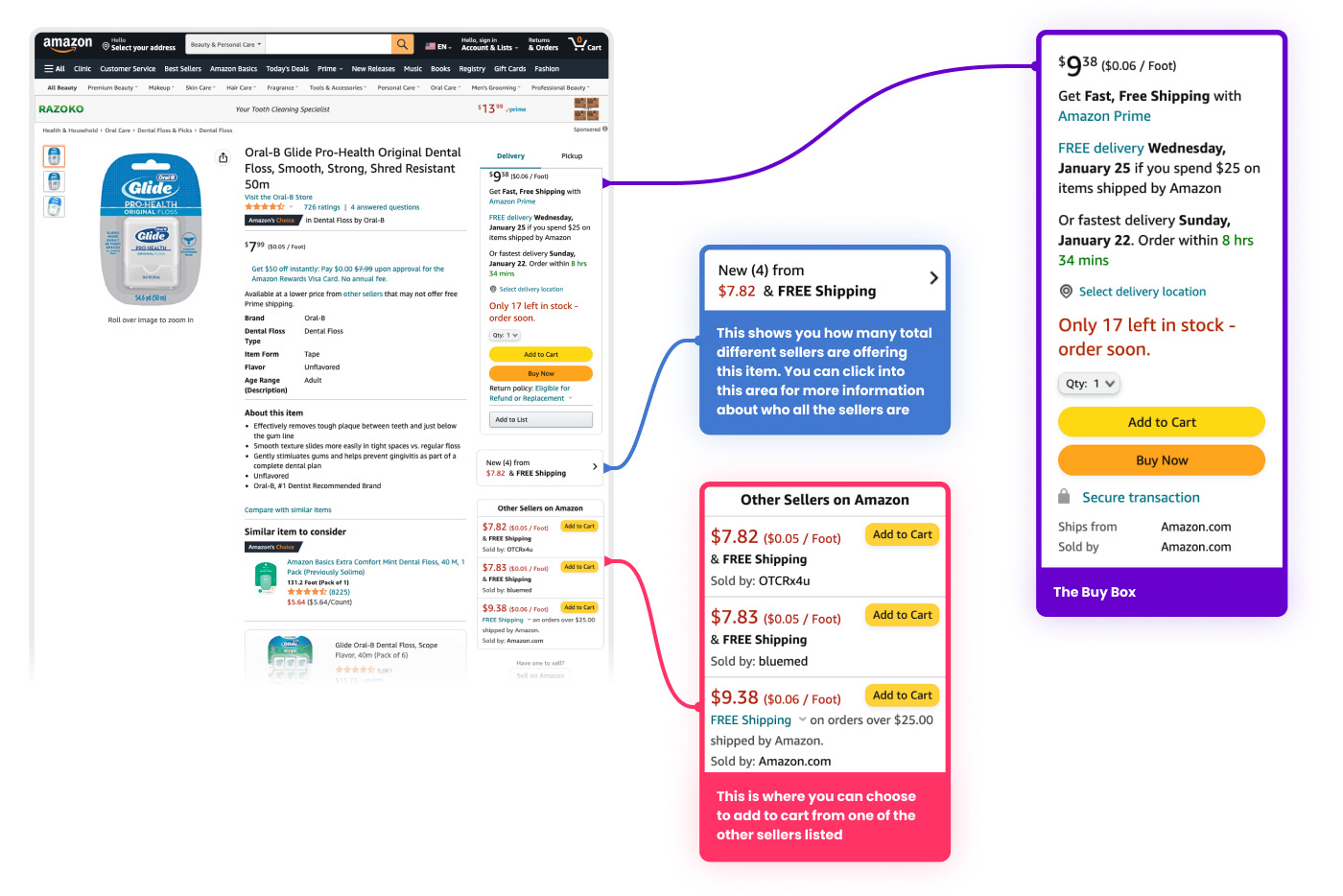
If you sell on Amazon and want to increase your sales, winning the Buy Box is crucial. Obtaining and retaining Buy Box ownership requires that you have a Professional Seller Plan, are competitively priced, and maintain Amazon’s performance requirements. Remember—the Buy Box is designed to make it as easy as possible for customers to purchase from the seller offering the best overall value. If that’s you, you’re not only more likely to win the Buy Box, but also to have sustained customer satisfaction.
Customers rely on authentic product reviews on almost every site they shop from, but thanks to Amazon’s size, products sold there tend to have a high number of reviews. Positive, helpful reviews are the social proof brands need to earn continued consumer confidence.
In soliciting reviews, be sure to adhere to Amazon’s customer product reviews policy. Encourage shoppers to leave reviews whenever possible, but don’t offer compensation for doing so. Also be sure to follow-up on any negative reviews, or neutral reviews that cite a concern. This will show prospective customers reading the reviews that if they have an issue with their purchase, they can count on support.
Amazon A+ content is available for select sellers on Amazon—currently including 1P vendors, emerging brand owners, and Amazon Brand Registry sellers. A+ content better conveys the value of your products through the use of detailed product descriptions, rich images, comparison charts and infographics, and/or videos.
Below is an example of an A+ content detail page:
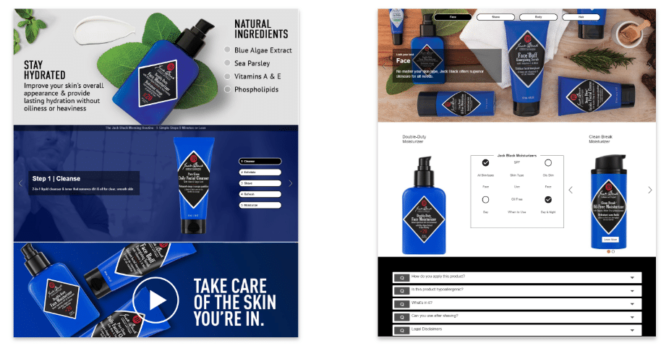
Using A+ content on Amazon has proven to increase conversion rates and reduce returns for many sellers. Think of everything a potential shopper might want or need to know about your product to be secure in their purchase decision, and account for that in the content you produce. This will vary based on your product and category, but enhanced user experience and customer confidence is at the core of all A+ content.
Years ago, having a solid organic strategy was enough for many sellers to find success on Amazon. Today, with increased competition and overall growth of the site in mind, Amazon is a bit of a pay-to-play space for the most visibility. For that reason, sellers should be prepared to invest in advertising for their Amazon listings.
There are 3 main, self-serve categories of ad space that brands and sellers can purchase directly from Amazon:
A fourth advertising avenue to consider is Amazon DSP. Similar to Sponsored Products, Brands, and Display, sellers don’t have to work directly with Amazon to leverage DSP. However, it is required that you work with an agency partner like Tinuiti to run Amazon DSP ads, making it less fully ‘self-serve’ than Sponsored Products, Brands, or Display, which brands and sellers can choose to run themselves, or work with an agency to manage.
Amazon Sponsored Products are pay-per-click (PPC) ads based on relevant keywords (and product targeting) that drive traffic to a specific, individual product listing within the Amazon platform. Sponsored Products ads are shown within shopping results, and on product detail pages.
These search ads are Amazon’s flagship ad format and are a key investment for brands across all categories for driving awareness and conversions on Amazon’s marketplace.
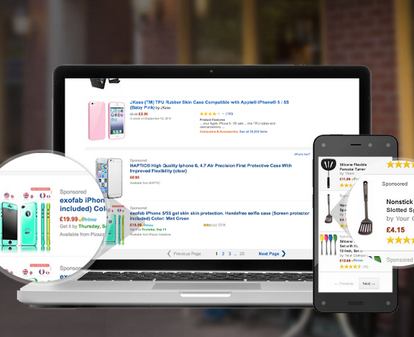
Sponsored Brands ads (formerly Headline Search ads) allow advertisers to feature custom headlines, up to 3 products, and brand creative—including their brand logo—to engage potential customers at the beginning of their shopping journey. Sponsored Brands banner ads are served within, alongside, or at the top of relevant Amazon shopping results to increase visibility with the right shoppers. These ads direct shoppers to specific product listings on Amazon, or your Amazon Store home page.
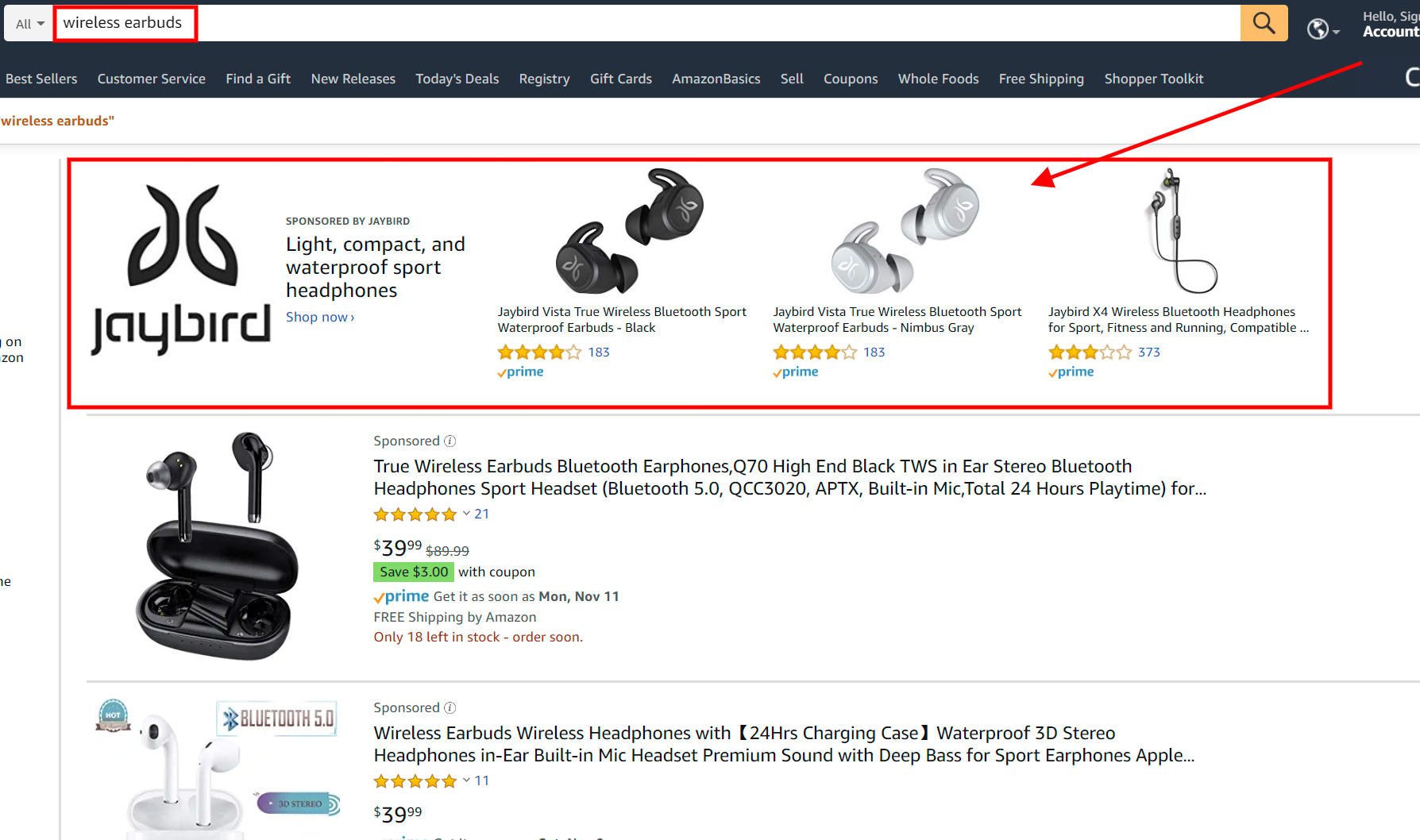
Sponsored Brands video: The use of video is on the rise across digital advertising on the whole, and Amazon is no exception. Sponsored Brands video ads are designed to educate shoppers about your product, and commonly include demonstrations, use-case examples, and top takeaways about product features. These videos should be short, informative, and product-focused; ideally 15-30 seconds in length.
Sponsored Brands video ads best practices include:
Once you’ve laid the foundation with Product collection and Video ads, consider exploring more advanced Sponsored Brands opportunities and formats, including Store spotlight ads for Amazon Store owners.
Sponsored Display is a self-service advertising solution that helps you “engage and re-engage shoppers, on and off Amazon” using shopping and contextual signals. In other words, Sponsored Display ads are effective for reaching entirely new audiences, and for retargeting.
These easy-to-setup-and-launch ads are available for 1P vendors and professional sellers enrolled in Amazon Brand Registry, and are offered with your choice of a CPC or vCPM pricing structure.
Sponsored Display ads can prove beneficial across the full funnel, with optimization strategies including: Optimize for viewable impressions; Optimize for page visits; Optimize for conversions. Because these ads can display deals and savings badges, they can prove especially valuable during Amazon sales events or brand-specific promotional periods.
Where your Sponsored Display ads will appear on and/or off Amazon is determined by your targeting strategy—available tactics include product targeting and audiences.
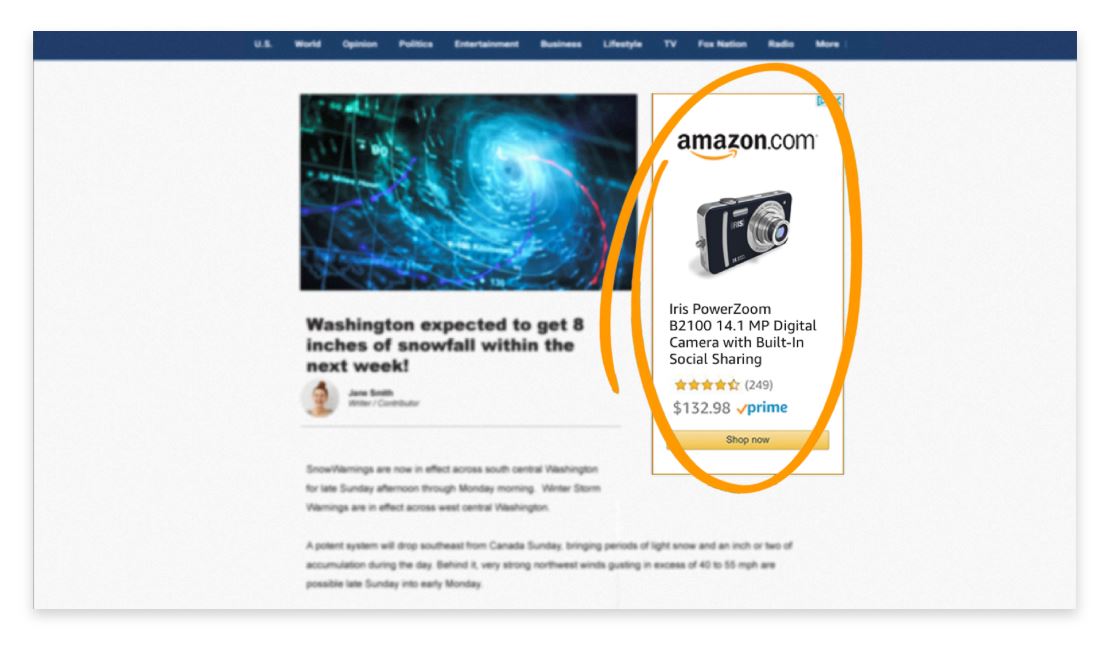
Sponsored Display ads are ideal for building mid-funnel awareness, helping inform, engage, and convert shoppers. As discussed in our post on Amazon’s blog—How to approach display advertising with Tinuiti—these ads help advertisers “access display inventory without the higher requirements of Amazon DSP.”
“Sponsored Display’s customization features help you tell your brand story and increase campaign performance. Sponsored Display allows you to refresh or edit specific campaign sections, rather than starting from scratch.You can use updated creative elements such as images, headlines or logos for increased seasonal relevance.” — Amazon
Amazon DSP — also known as the Amazon Demand-Side Platform — gives brands and sellers the ability to programmatically buy video, audio, and display ad placements. Programmatic ads use available data to determine which digital advertising spaces you’ll buy, and how much you’ll pay for them.
Amazon DSP allows brands to use Amazon targeting capabilities in showing ads to new and existing customers on Amazon owned-and-operated web properties, in addition to those it does not control. Even brands that aren’t selling products on Amazon can advertise using Amazon DSP.
Amazon DSP unlocks incredible opportunities for brands and sellers, and we expect the unique ad options and capabilities will only continue growing. Some current forward-thinking DSP advertising options include streaming TV ads on Fire Stick, and in-store screen ads in Whole Foods stores. If you want to reach customers in these spaces, DSP is the way to do it.
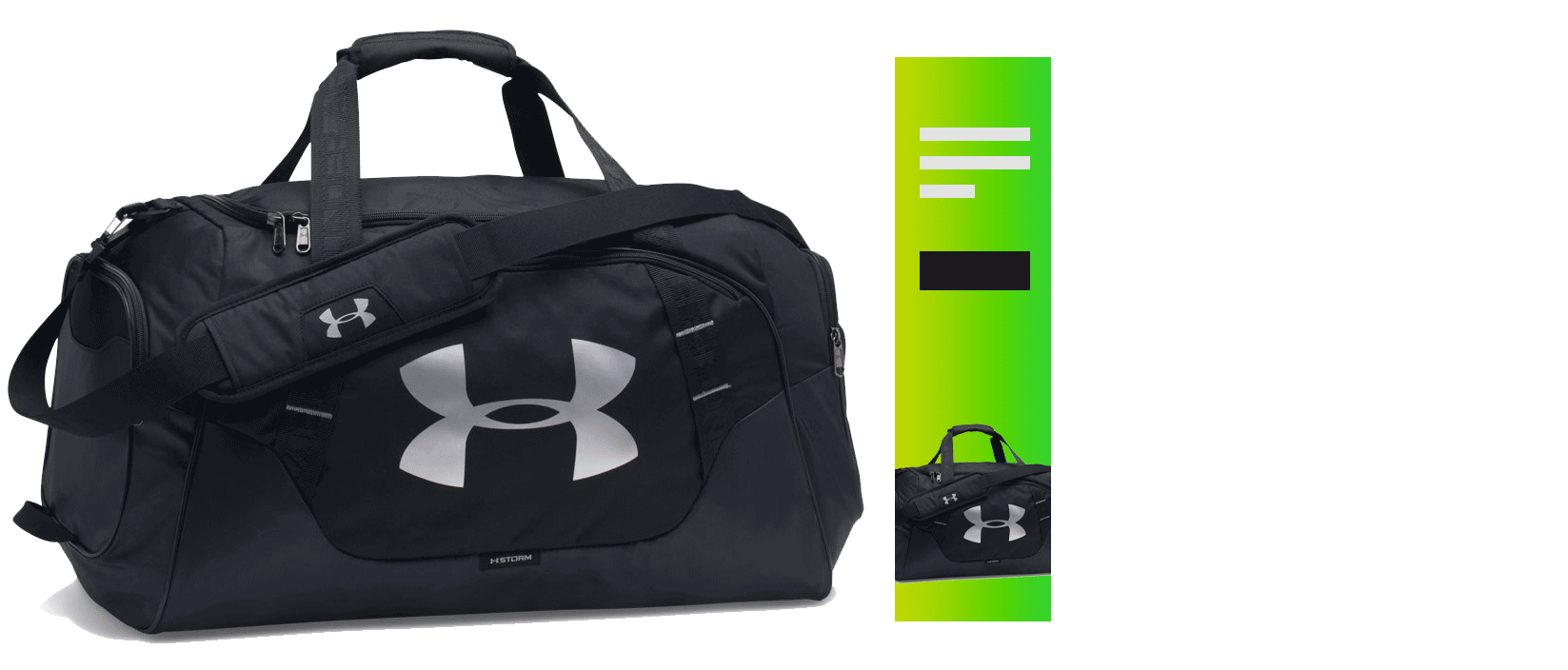
Amazon Stores are a free self-service product that allows brand owners to design and create multipage stores to showcase their brands, products, and value proposition on Amazon. If we think of Amazon.com as a shopping mall, Amazon Stores are the individual retail spaces within.
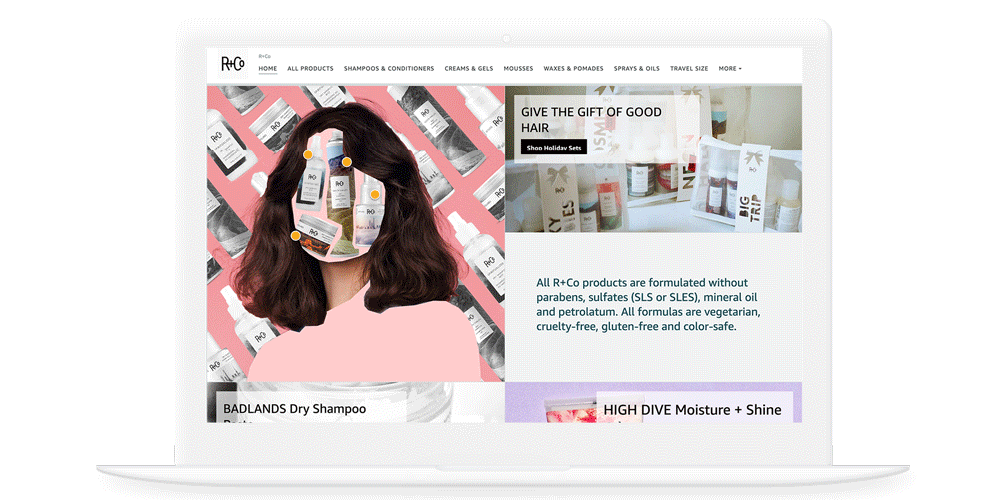
Setting up an Amazon Store is crucial for brand-building on Amazon, but the process can take some time and expertise to efficiently navigate. For that reason, many sellers choose to work with a reputable Amazon agency like Tinuiti to build, design, and optimize their Store.
Here are some of the benefits of working with an experienced Amazon agency to build your Amazon Store:
Some final considerations to make include whether to sell internationally, how Amazon Attribution and Brand Registry can help you grow and protect your brand, and how those fees all stack up. Let’s dive into each…
The cost to sell on Amazon is largely determined by which selling plan you choose, and how you’re planning to handle fulfillment.
As we mentioned earlier, Amazon sellers can choose between a Professional or Individual selling plan. Individual sellers pay $0.99 for each item sold on Amazon, plus referral and additional selling fees. Professional sellers also pay referral and additional selling fees, with a $39.99 monthly charge that exempts them from the $0.99 per item sold fee.
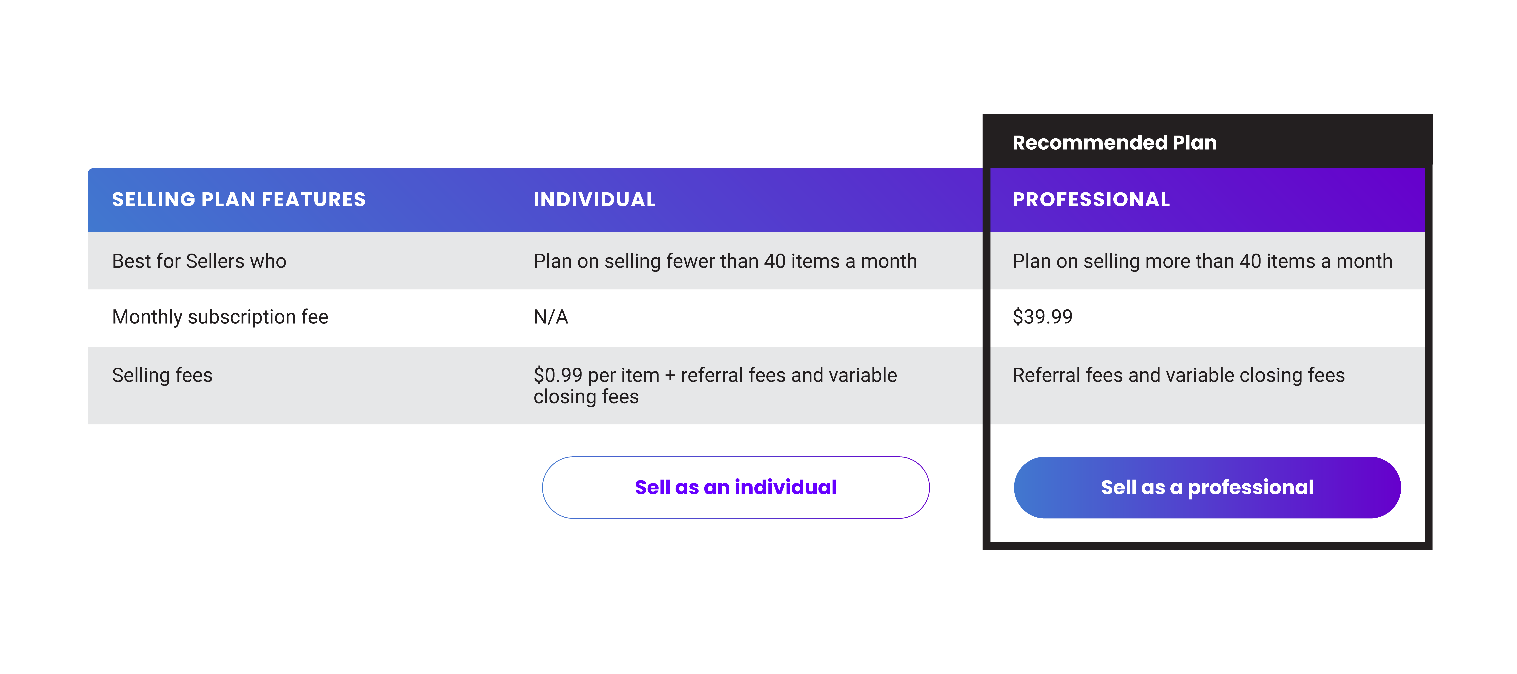 Visit Amazon’s pricing page for a fuller breakdown of Amazon fees and additional cost considerations and incentives.
Visit Amazon’s pricing page for a fuller breakdown of Amazon fees and additional cost considerations and incentives.
Amazon Attribution is a measurement solution that provides advertisers with valuable insights into how their non-Amazon marketing channels are performing on Amazon; these reports include both orders and revenue for traffic originating off Amazon. It can measure traffic brought directly to Amazon, as well as traffic to a site that later converts on Amazon. This arms advertisers and brands with the necessary shopper journey information to optimize their media campaigns, and grow product sales.
Amazon Attribution can measure traffic from nearly any source, including search ads, display ads, social ads, video ads, and email marketing. Through the creation of orders and line items, brands can create unique tracking templates, and performance can be measured to their desired level of granularity.
There is currently no cost to participate in Amazon Attribution, but it is only available to eligible sellers and vendors, including: “professional sellers enrolled in Amazon Brand Registry, vendors, KDP authors, and agencies with clients who sell products on Amazon.”
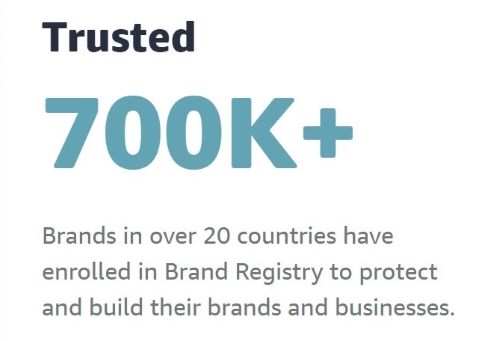
The Amazon Brand Registry gives brand owners access to proprietary text, image search, predictive automation, and reporting tools designed to protect their registered trademarks and create an accurate and trusted experience for customers.
The Amazon Brand Registry also allows brands to search for content using images, keywords, or a list of ASINs in bulk, and report suspected violations through a simple, guided workflow.
Let’s talk about why this is important for sellers.
While selling on Amazon, you may experience counterfeit issues or situations where your product content is changed by a third party seller.
The Amazon Brand Registry provides a necessary set of tools that may help sellers avoid these issues— including Transparency by Amazon, Project Zero, and Counterfeit Crimes Unit.
Here’s how Amazon’s Brand Registry works, how to enroll, and other brand protection programs that you can use to prevent third-party sellers from counterfeiting your products on the marketplace.
To become a member of the Amazon Brand Registry you must:
In the beginning stages, it’s common for sellers to experience a combination of excitement and fear at the prospect of selling products internationally. Common concerns like credit card fraud and shipping delays may seem overwhelming at first, but with the right guidance, sellers can avoid common mistakes and simplify their global expansion process.
The decision to go global is often driven by a combination of factors—some financial, and others related to marketing, merchandising or operations. It can be a lucrative decision for some sellers, but not all. We recommend honing in on your primary goals in going global to determine if it’s the best move for your business.
For many sellers and brands, absolutely!
With the right products, sophisticated marketing tactics, helpful tools, and seller support, brands selling on Amazon can see great success. Although the competition for almost every category on the marketplace is fierce, there are still plenty of opportunities for brands to thrive.
To be a successful Amazon seller, you should:
And most importantly, be prepared for whatever Amazon throws your way. Changes can (and do) happen every single day. Looking for a partner to help you navigate these challenges? We’d love to hear from you!
Editor’s Note: This post was originally published by Tara Johnson and has been regularly updated for freshness, accuracy, and comprehensiveness.
